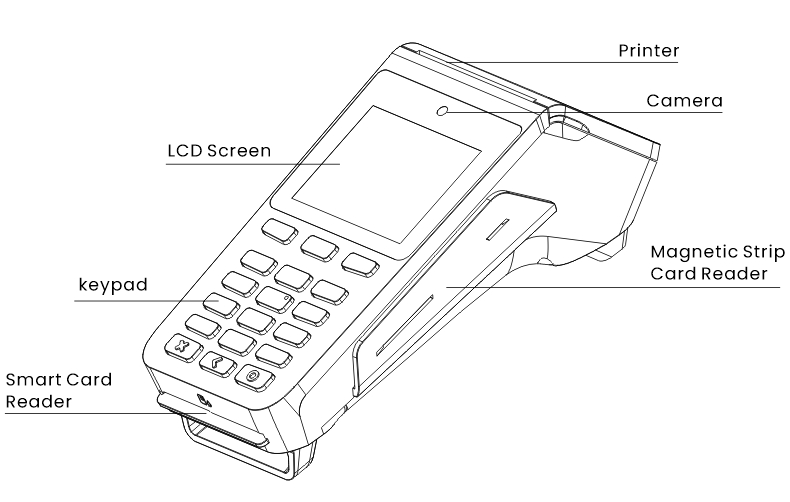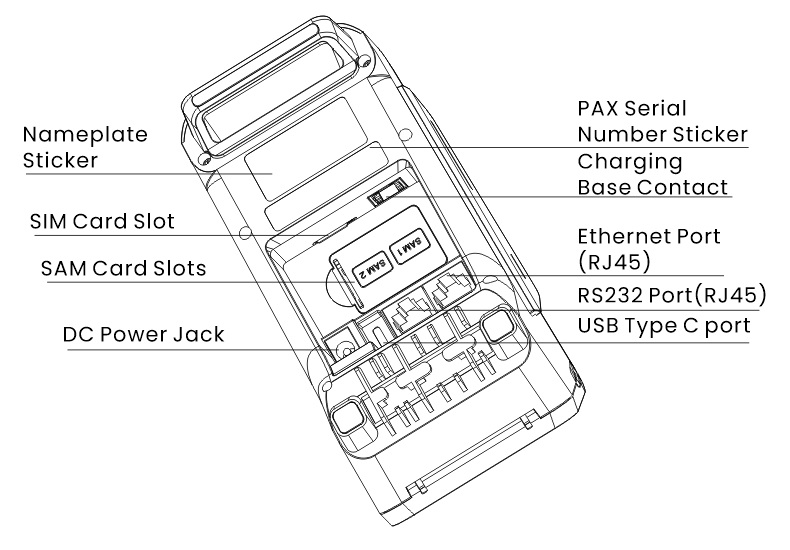Q58 Quick Setup Guide Table of Contents
| Name | Qty. |
| Q58 | 1 |
PRODUCT DESCRIPTION
Installation
- POWER Port: Connects to the external power adapter.
- LINE Port: Connects to the telephone line (optional).
- RS232 Port: Connects to the serial port.
- LAN Port: Connects to the network cable.
- USB (OTG) Port: Connects to a USB drive or other devices, and is used for terminal downloads.
- SAM Card: Remove the cover at the bottom of the terminal and insert the SAM card into the corresponding slot.
- SIM Card (optional): Insert the SIM card into the designated slot.
Instructions
Power ON/OFF
- Power On: Press and hold the ON/OFF button for 2 seconds until the terminal powers on.
- Power Off: Press and hold the ON/OFF button for 2 seconds to bring up the Power Off confirmation box. Select “YES” to turn off the terminal.
Magnetic Stripe Card
- Align the magnetic stripe side of the card toward the device’s interior. Swipe the card at a steady speed through the magnetic reader slot. (Supports bi-directional swiping.)
IC Card
- Insert the IC card with the chip side facing up and push it into the slot until fully seated.
Paper Shredding Instructions
- Position the paper at a 45-degree angle to the paper cutter for shredding.
Contactless Card
- Hold the contactless card over the designated area above the printer cover.


Maintenance and Usage
- Avoid placing the terminal in direct sunlight or in environments with high temperatures, moisture, or dust.
- If repairs are required, contact PAX support. Only qualified professionals are authorized to repair the terminal. Non-professionals must not attempt repairs.
- Before inserting a card, inspect the interior and surrounding area of the IC card slot. If any suspicious objects are detected, report them to the designated administrator.
- The terminal operates without a battery and is intended for use exclusively on a desktop through an adapter. It must remain stationary on the desktop while in operation.
CAUTION: Changes or modifications not expressly approved by the party responsible for compliance could void the user’s authority to operate the equipment.
Password Entering Tips
It is highly recommended to secure password entry as follows:
- Set up privacy shields around the cashier area to protect password entry.
- Position the POS terminal at an angle that makes it difficult for others to view the entered password, such as installing it on a movable bracket.
- Ensure the area used for password entry is free from surrounding video surveillance to maintain privacy.
- Display text instructions reminding customers to shield their entry with their body or hand when entering their password.
- Merchants may also consider additional methods to protect customers during password entry.
FCC Regulations
This device complies with part 15 of the FCC Rules. Operation is subject to the following two conditions:
- This device may not cause harmful interference, and
- This device must accept any interference received, including interference that may cause undesired operation.
This device has been tested and found to comply with the limits for a Class B digital device, pursuant to Part 15 of the FCC Rules. These limits are designed to provide reasonable protection against harmful interference in a residential installation. This equipment generates, uses and can radiated radio frequency energy and, if not installed and used in accordance with the instructions, may cause harmful interference to radio communications.
However, there is no guarantee that interference will not occur in a particular installation If this equipment does cause harmful interference to radio or television reception, which can be determined by turning the equipment off and on, the user is encouraged to try to correct the interference by one or more of the following measures:
- Reorient or relocate the receiving antenna.
- Increase the separation between the equipment and receiver.
- Connect the equipment into an outlet on a circuit different from that to which the receiver is connected.
- Consult the dealer or an experienced radio/TV technician for help.
Caution: Changes or modifications not expressly approved by the party responsible for compliance could void the user‘s authority to operate the equipment.
ISED Compliance Statement
This device contains licence-exempt transmitter(s)/receiver(s) that comply with Innovation, Science and Economic Development Canada’s licence-exempt RSS(s). Operation is subject to the following two conditions:
- This device may not cause interference.
- This device must accept any interference, including interference that may cause undesired operation of the device.
L’émetteur/récepteur exempt de licence contenu dans le présent appareil est conforme aux CNR d’Innovation, Sciences et Développement économique Canada applicables aux appareils radio exempts de licence. L’exploitation est autorisée aux deux conditions suivantes:
- L’appareil ne doit pas produire de brouillage;
- L’appareil doit accepter tout brouillage radioélectrique subi, même si le brouillage est susceptible d’en compromettre le fonctionnement.

